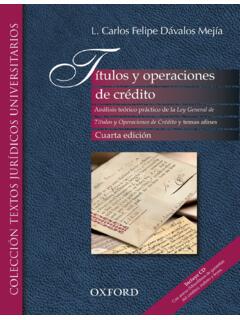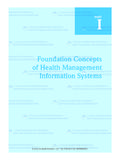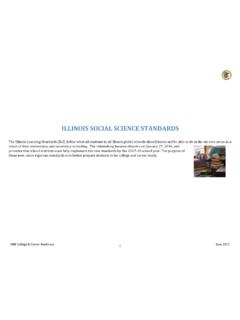Transcription of CRIMINOLOGY: The Key Concepts - sijufor
1 CRIMINOLOGYC riminology: The Key Conceptsis an authoritative and comprehensivestudy guide and reference resource that will take you through all theconcepts, approaches, issues and institutions central to the study ofcrime in contemporary covered in this easy-to-use A Z guide include: policing, sentencing and the justice system; types of crime, including corporate crime, cybercrime, sex andhate crimes; feminist, Marxist and cultural approaches to criminology , terrorism, state crime, war crimes and human rights; social issues such as antisocial behaviour, domestic violence andpornography; criminal psychology and cross-referenced, with extensive suggestions for further readingand in-depth study of the topics discussed, this is an essential refer-ence guide for students of criminology at all O Brienis Reader in criminology at the University ofCentral Lancashire.
2 He is the author, with Sue Penna, ofTheorisingWelfare: Enlightenment and Modern Society(1998), and editor ofIntegrating and Articulating Environments: A Challenge for Northern andSouthern Europe(2003).Majid Yaris Senior Lecturer in criminology and Director of theCentre for Criminological Research at Keele University. He haspublished widely in the areas of social and political theory, criminol-ogy, continental philosophy, cultural analysis and philosophy of socialscience, and is the author ofCybercrime and Society(2006).ALSO AVAILABLE FROM ROUTLEDGEC riminology: the basicsSandra Walklate978-0-415-33554-6 Available soon from RoutledgeFifty Key Thinkers in CriminologyKeith Hayward et Key ConceptsMartin O Brien and Majid YarFirst published 2008by Routledge2 Park Square, Milton Park, Abingdon, Oxon OX14 4 RNSimultaneously published in the USA and Canadaby Routledge270 Madison Ave, New York, NY 10016 Routledge is an imprint of the Taylor & Francis Group, an informa business#2008 Martin O Brien and Majid YarAll r ights reser ved.
3 No par t of this book may be repr inted or reproduced or utilised in anyform or by any electronic, mechanical, or other means, now known or hereafter invented,including photocopying and recording, or in any information storage or retrieval system,without permission in writing from the Library Cataloguing in Publication DataA catalogue record for this book is available from the Br itish Librar yLibrary of Congress Cataloging in Publication DataO Brien, Martin, 1957 criminology : the key Concepts / MartinO Brien and Majid bibliographical criminology . I. Yar, Majid. II. 2008364 dc222007050909 ISBN10: 0-415-42793-2 (hbk)ISBN10: 0-415-42794-0 (pbk)ISBN10: 0-203-89518-5 (ebk)ISBN13: 978-0-415-42793-7 (hbk)ISBN13: 978-0-415-42794-4 (pbk)ISBN13: 978-0-203-89518-4 (ebk)This edition published in the Taylor & Francis e-Library, 2008.
4 To purchase your own copy of this or any of Taylor & Francis or Routledge scollection of thousands of eBooks please go to ISBN 0-203-89518-5 Master e-book ISBNCONTENTSList of key conceptsviIntroduction: The Concepts of criminologyviiiKEY CONCEPTS1 Bibliography188 Index208vLIST OF KEY CONCEPTSA ctuarial justiceAdministrative criminologyAlienationAntisocial behaviourBiological criminologyChicago School criminologyClassClassical criminologyCommunityCommunity crime preventionand community safetyCommunity sentences andcommunity punishmentsConstitutive criminologyCorporate crimeCrime and devianceCrime dataCrime mappingCriminal careersCriminal justice systemCriminal psychologyCritical criminologyCultural criminologyCultural transmissionCybercrimeDevelopmental criminologyDeviance amplificationDifferential associationDiscourseDrug crimeDurkheimian criminologyEnvironmental crimeEnvironmental criminologyFamily crimeFeminism and criminologyGangsGenderGovernance and
5 GovernmentalityGreen criminologyHate crimeHedonismHegemonyHomophobiaHuman rightsIdealismIdentityIdeologyIntellectu al property crimeJusticeLabelling perspectivesMarxist criminologyMass mediaMoral panicNet-wideningNew mediaNormsObscenity and pornographyOrganised crimePeace-making criminologyPolicing and the policePositivist criminologyPostmodernity/postmodernismPr isons and imprisonmentProperty crimeviPunishmentRacismRational choiceRealismRestorative justiceRiskRoutine activity theoriesSex crimesSexismSocial controlSocial control perspectivesSocial exclusionSocial harmSocialisationState, theState crimeStreet crimeSubcultural criminologiesSurveillanceTechniques of neutralisationTerrorismUnderclassVictimo logyViolent crimeWar crimesWhite-collar crimeYouth crimeZero toleranceLIST OF KEY CONCEPTSviiINTRODUCTIONThe Concepts of criminologyDuring a period of extensive change and expansion in British highereducation the growth of university-level programmes in criminologyhas been a notable feature.
6 From London to Lothian, Salford toSwansea and Birmingham to Belfast there is hardly a higher educa-tion institution that does not now offer a degree programme incriminology and criminal justice. For those interested in committingthemselves to formal study in this area there exists a plethora ofoptions. This picture was very different less than one generation the very recent past undergraduate degrees in criminology wereconfined to one or two universities, alongside a small handful ofinstitutions offering crime-focused postgraduate degrees. The socialscientific study of crime was dispersed across disciplines such associology, social policy, social work, psychology, and law. Studentswould be offered occasional modules on the sociology of crime , criminal justice policy , or social work with offenders as part ofdegree programmes whose primary mission was to impart a wide-ranging, discipline-based education.
7 Now, crime has become thesole focus of dedicated degree programmes rather than studying itin passing as part of some discipline or other, students can dedicatethemselves to its study through the lenses of different disciplinaryperspectives. The people who teach criminology nowadays arethemselves representative of this variety they come to the subjectmatter of crime from disciplinary backgrounds that most commonlyinclude sociology (as with the authors of this book), social policy,psychology, history, anthropology, economics, law and politicalscience. Each has a different light to shine upon crime and itsassociated problems, a distinctive way of looking, explaining andunderstanding. This is all to the good, as it exposes students to a widevariety of ways in which crime-related issues can be conceptualised,contextualised and analysed.
8 For example, a psychologist will likelyexplain a particular kind of crime in a distinctive way, focusing uponthe cognitive and/or developmental processes that might helpviiiaccount for an individual s actions. A sociologist, in contrast, willmore likely examine the same phenomenon in the context of culturalnorms and values, an individual s relationships with social groups, orthe workings of power, exclusion and disadvantage in society at historian may take yet another tack, seeking to understand whathappens in the present by reference to the past, viewing the roots ofcurrent events and problems in light of long-term developments thatmight have begun decades or even centuries ago. These are, ofcourse, simplifications but they point to the richness of criminology ,the heady mix of debates and disputes, and the kaleidoscopic char-acter of different viewpoints that focus on a single object of , the aforementioned variety also represents one of themajor challenges facing criminology students: the expectation thatthey come to grips with the Concepts , methods and tools of differentdisciplinary perspectives.
9 Equally, it tests those of us who teachcriminology, as we are required to step outside of our own dis-ciplinary comfort zone and familiarise ourselves with insights andarguments originating students appetite for criminology is currently all too evident,very few embark upon a degree-level programme of study with morethan a vague understanding about what such study actually entails,beyond a general sense that crime is interesting, important andworth knowing about. Indeed, some students starting their universitycareer arrive with assumptions about what they are about to spendthree or four years studying that may be unhelpful and, sometimes,inaccurate. These misapprehensions are no doubt shaped by everydaydebates about crime. Students (like everyone else) are exposed toextensive media coverage about crime, which tends to deal pre-dominantly with a small number and type of offences, such asmurder, terrorism , and child sex abuse and abduction (we need onlythink about the coverage given to the Soham murders, the crimes ofDr Harold Shipman, or the disappearance of Madeleine McCann toget a sense of where news reporting tends to focus).
10 Moreover, factualaccounts are supplemented with a veritable deluge of crime-relatedfictions on television and in film. Shows such asSpooks,Fatal Witness,Waking the Dead, The Bill,Cracker,Wire in the Blood,CSI(Las Vegas,Miami and New York),Criminal Minds,Without a Trace,24,TheSopranos,Bones, andPrison Breakall communicate assumptions about the crime problem what crimes are committed, who commitsthem, why they do so, and how they are brought to justice andpunished. While the entertainment value of such shows is not indispute (criminologists, like everyone else, are avid fans), they have anINTRODUCTION ixunfortunate tendency to paint a misleading picture about the realityof crime in our society. Perhaps every lecturer in criminology hasbeen approached at some time or another by an enthusiastic potentialstudent who confesses a burning desire to learn how to profile serialkillers, conduct a blood spatter analysis, or track down bad guys ,only to be gently told that whilst these tasks are important they areonly a very small part of what criminology is about and that there is avery long road to travel from initial expectation to final destination.















